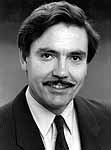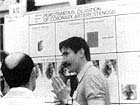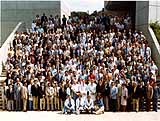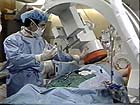Biographical Sketch of
Andreas R. Gruentzig (1939-1985) |

Andreas R.
Gruentzig, MD |
After employing Dotter's techniques of transluminal angioplasty, which he had learned from Eberhart Zeitler in Nuremberg, Andreas Gruentzig, a young German physician working at University Hospital in Zurich, Switzerland, began toying with the idea of adding a balloon to the Dotter catheters.
He started fashioning prototypes in his own kitchen, searching for a viable material and design. In 1975 he developed a double-lumen catheter fitted with a polyvinylchloride balloon that would set in motion a revolution in medicine.

Gruentzig's Poster Exhibit at 1976 AHA |
He presented the results of animal studies with the balloon at the American Heart Association meeting in 1976 and was met with skepticism, although a few individuals saw the potential of his work. Dr. Richard Myler of Saint Mary's Hospital in San Francisco suggested they collaborate and the two performed the first human coronary angioplasty intraoperatively during bypass surgery in San Francisco.
In September 1977, in Zurich Switzerland, Gruentzig performed the first coronary angioplasty on an awake human. Now, a year later, when he presented the results of his first four angioplasty cases to the 1977 AHA meeting, the audience burst into applause, acknowledging his breakthrough with a standing ovation.

Emory Course 1981 |
Gruentzig began a careful, rigorous process of furthering and disseminating the technique through live demonstration courses, first in Zurich and then at Emory University in Atlanta, and establishing a PTCA registry at the National Heart, Lung and Blood Institute to gather and share experience.
Throughout the 1980's, improvements in angioplasty technology continued exponentially.
Gruentzig's breakthrough was a synthesis of all that had come before and because of the brilliant way in which he fostered its acceptance, the field of interventional cardiology has forever altered the role of the cardiologist in treating coronary artery disease.
The 7 minute video clip below is the story of the first coronary angioplasty and it is told by people who were there: Bernhard Meier, MD, FACC, Chair of the Swiss Cardiovascular Center, University Hospital in Bern, Switzerland; Maria Schlumpf, who was Andreas Gruentzig’s assistant in Zurich, until he moved to Emory University Hospital in 1980; Adolph Bachmann, the first angioplasty patient, who still lives in Switzerland; and John E. Abele, retired Founder Chairman of Boston Scientific who has been involved in many educational and organizational efforts regarding technology and its impact on our lives.
Our award-winning documentary "PTCA: A History," from which this clip is excerpted, was made possible by an educational grant from Mr. Abele. For those interested in seeing the complete story, the 72-minute DVD is for sale on our web site.
|
Video not loaded
|
| The First Coronary Angioplasty, from "PTCA: A History"
|
|




